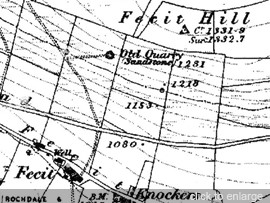
The first edition of the Ordnance Survey map shows an example of an “old” sandstone quarry on the edge of Fecit Hill, near Turn Village. This map was surveyed around 1850, so the quarry was “old” at that time. The track down the hillside to Fecit Farm indicates that this is probably where the stone was taken. Fecit Hill is common land and commoners, farmers with rights to graze livestock on the common, have a right to quarry stone for use on their own land.